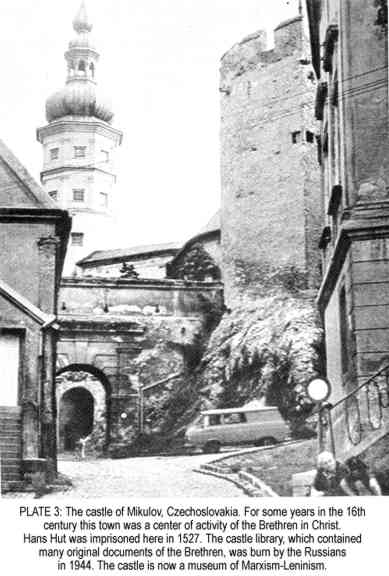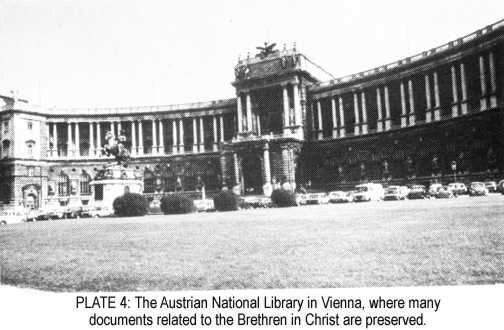
Last Updated on :
Saturday, November 22, 2014
- Information
- Articles Books Booklets
- Commentaries
- Daily Readings
- Hymns/Music
- Study Aids
- Basis of Belief
- Doctrines we reject
- Commandments of Christ
- Christadelphian Instructor
- Sisters
- Read it in a year
- Downloads PDF/Word
- Mobile Files Old Home Page
- _____
Brethren In Christ
BY ALAN EYRE
All images on these pages can be viewed at a readable size by clicking on the corresponding link.
PAGE 35
Take the road north from Vienna for about seventy miles and cross the fearsome 'iron curtain' border into Czechoslovakia. The first town beyond the frontier is Mikulov. From a distance, the town looks like a picture out of a book of fairy tales, with its huge castle dominating the massed red roofs below. In fact, the ancient streets and buildings are neglected, dirty and ruinous (Plate 3).
In 1526, protected by friendly princelings who ruled this region of Moravia, groups of Brethren in Christ found refuge and sought to develop a vigorous witness and an organized ecclesial life. For just a few years, they had a modicum of freedom to do so; then their efforts were crushed by the combined might of the Papacy and the Holy Roman Empire. These two, in concert, sought to wipe out every memory of this faithful witness.
Three and a half centuries later a German professor of linguistics, Wendelin Foerster, wrote in an obscure German journal the following:
"About twenty-five years ago, when passing through Mikulov, I stopped briefly to visit the castle library of the noted Prince Dietrichstein. I was interested in the little-understood relationship between the Waldenses (Vaudois) and the Brethren in Christ in Moravia, and I soon realized that this library contained a rich treasure. This flying visit indicated that here was a huge quantity of hand- written manuscripts and other valuable works." 88
Sad to say, this library is no more. In 1944 the advancing Russian forces set fire to the castle, and everything in it was completely destroyed. The old Mikulov castle is now a museum of Marxism-Leninism. Amidst all the exhibits glorifying Man, and war and revolution is a small alcove with an exhibit of a different kind. A mask of Balthasar Hubmaier, taken in life during the year 1526 when he lived in Mikulov, looks down from the wall, and below is an inscription in Czech:
BALTHASAR HUBMAIER
It is in Mikulov and vicinity that his output of writings of a religious and secular character attained the full flower of maturity. He promulgated the ideology of the Brethren in Christ not only at Mikulov but throughout southern Moravia. With the help of his assistant Frohschauer, eighteen works were published in Mikulov.
PAGE 36
PLATE 3: The castle of Mikulov, Czechoslovakia. For some years in the 16th century this town was a centre of activity of the Brethren in Christ. Hans Hut was imprisoned here in 1527. The castle library, which contained many original documents of the Brethren, was burnt by the Russians in 1944. The castle is now a museum of Marxism-Leninism.
. . . . .
 Though the "rich treasure" has gone up in smoke, not all is lost. Copies of many of the "eighteen works" and other documents are in the great Austrian National Library in Vienna (Plate 4). The Czechs
Though the "rich treasure" has gone up in smoke, not all is lost. Copies of many of the "eighteen works" and other documents are in the great Austrian National Library in Vienna (Plate 4). The Czechs
PAGE 37 Inset: BALTHASAR HUBMAIER 1482-1528
have excavated one of the printeries of the Brethren in Kralice and opened it to the public as a national monument (Plate 6). Letters from Mikulov to members in Italy are preserved in Venice (Plate 7). From such sources we can piece together a fascinating picture of ecclesial life
 PAGE 38
PAGE 38
in Moravia in the 16th century. Many of the documents have a unique warmth and power, revealing the influence of the Truth upon hearts newly won from popish superstition and medieval ignorance.
Hubmaier's Mikulov documents are of particular interest to us today. One of them is entitled Christian Teaching every person should know before he is baptized; it is a remarkable parallel to Robert Roberts' A Good Confession. It is in the familiar form of an interview between Leonard (the interviewer) and John (the candidate). Consider that this is 1526, that for a thousand years the Dark Ages had benighted the earth, and that papal superstition's chains still held most of the known world in thralldom, that printing of the Bible (or of anything else) was still a new invention, and the marvel of this document is seen to be all the greater. Beginning with questions on man, God and sin, it goes on to deal with the Promises to Eve, Abraham and David, and their fulfilment (see FROM "A GOOD CONFESSION" IN 1526 for a small excerpt of this document).
Another document describes a sequence of events that will be familiar to every Christadelphian reader. In a world of popish monks and priests, its impact must have been startling in the extreme, a veritable revolution. It was written by Hubmaier to Lord Bubschanski of Znojmo, perhaps to allay suspicions about what was going on within his territory. Znojmo is a town about forty miles from Mikulov (see JOINING THE ECCLESIA-ZNOJMO 1526 for a short excerpt).
A third document of Hubmaier's gives us a fleeting, yet intimate glimpse into an ecclesial meeting room in Mikulov in 1526. (see A MEMORIAL SERVICE IN MIKULOV 1526). It is an exhortation to us all today. We might, for instance, profitably note the brief but meaningful simplicity of the thanks for the bread - a contrast to the long and verbose prayers sometimes heard at that juncture in our meetings.
glimpse into an ecclesial meeting room in Mikulov in 1526. (see A MEMORIAL SERVICE IN MIKULOV 1526). It is an exhortation to us all today. We might, for instance, profitably note the brief but meaningful simplicity of the thanks for the bread - a contrast to the long and verbose prayers sometimes heard at that juncture in our meetings.
One of the "eighteen works" referred to in the Mikulov museum is Thirteen Reasons why you should be baptized. Signed "B.H." and dated 1527, it is dedicated to Lord Jan von Bernstein of Holfenstein, my gracious master", and carries the subtitle:
"Reason and cause why anyone who was christened in infancy is under obligation to be baptized according to the ordinances of Christ, even though he be a hundred years old".
The final four reasons and conclusion are reproduced here (see BALTHASAR HUBMAIER ON BAPTISM, p.46).
PAGE 39
PLATE 4: The Austrian National Library in Vienna, where many documents related to the Brethren in Christ are preserved.
PLATE 5: The great monastery at Melk, on the Danube in Austria. Typical of many set up by Pope and Emperor to combat the spread of Bible teaching through Europe, their libraries sometimes preserve documentary evidence of (he activities of the Brethren in Christ.
PAGE 40
PLATE 6: Bible of the Czech Brethren, and types from which it was printed. Found at excavated Brethren's printery, Kralice, Trebic district, Czechoslovakia, now a national monument. At this secret press, from 1579 to 1594, they printed Bibles translated from the original languages, and many other tracts. Destroyed by the Catholics, it was discovered in 1956, along with four thousand pieces of metal type. It is considered, for its age and preservation, unique in the whole world.
PAGE 41
PLATE 7: Handwritten letter in Italian from Brethren in Moravia to fellow- believers in Italy, warning them of the dangers of the Josephite heresy.
PAGE 42 Inset: From A "Good Confession" In 1526
PAGE 43 Inset: Joining The Ecclesia -- ZNOJMO 1526
PAGE 44 Inset: A Memorial Service In Mikulov 1526
PAGE 45
The keen sense of fellowship which always characterized the Brethren in Christ was nowhere richer than in Moravia, especially at this time. This was mainly because the members, for security's sake, gathered in true communities (gemeinde, as they were called), often building small camps or villages where much of the work in field and home was shared. These camps were usually under the indirect protection of some powerful lord, count or prince who was prepared, for a time, to brave the wrath of the Imperial authorities and tolerate the Brethren.
The Bible Schools run by the Brethren provided not only sound teaching in God's Word for young and old, but were often the only means that the children of members had of getting any kind of schooling. There was no way that they could get places in religious or state schools, and in any case families were frequently on the move. The distressing frequency with which parents were imprisoned and executed made it imperative for the Brethren to make care and training of children a matter of priority. RULES FOR FAMILY BIBLE SCHOOL offers an unusually frank insight into life in a 16th century school of the Brethren in Christ somewhere in what is now Czechoslovakia.
For these brethren and sisters, commitment had to be total. At any moment the cruel hand of the law could fall upon them and the very least of them would have to face a hostile courtroom (see JAN AND VINCKEN VERVESTE FACE THE INQUISITION). In 1527, for example, when the publishing and preaching work of the Czech Brethren was at its peak, Hans Hut, a most beloved brother, was arrested and imprisoned in the Mikulov castle (Plate 3). He somehow
PAGE 46 Inset: Balthasar Hubmaier On Baptism
PAGES 47-48
escaped and engaged in a wide-ranging preaching tour through Austria. He went to Augsburg, to participate in the Augsburg mission conference mentioned earlier. He was arrested again there, and subjected to interrogation by methods astonishingly reminiscent of the Stalinists. Hut's ten-year old son Philip, who was allowed into the prison, tells how his father was tortured on the rack, then taken to his cell unconscious. A candle left by his side blew over and his straw 'bed' caught alight. By the time the warders arrived, Hut was dead. Defrauded of the fun of a trial, his corpse was tied to a chair, taken to court, condemned to 'death' and then burned at the stake.
Inset: From Rules for Family Bible School (Moravia, 16th Century)
PAGES 49-50 Inset: Jan And Vincken Verveste Face The Inquisition
All Books/Booklets, Editorials, and Articles are FREE and can be downloaded without permission.